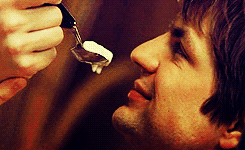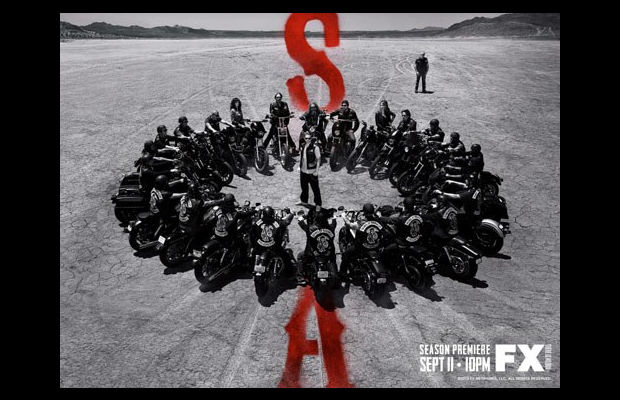This guest post by Rowan Ellis appears as part of our theme week on Masculinity.
If we were being cliche about it, we’d start this essay with a nice textbook definition of masculinity. “The Oxford Dictionary defines masculinity as…” But the thing is, the dictionary defines masculinity as “possession of the qualities traditionally associated with men,” and queer media, of which Queer as Folk (North American version) is but one example, should surely take issue with this very premise considering how heavily it relies on assumptions around a gender binary that doesn’t really exist. Queer as Folk is overwhelmingly about men, but they are men living in a subculture with different “traditional qualities.” Queens, Bears, Straight-Acting, Leathers… any number of ideals of what it is to be a certain type of man in a certain type of tradition. When sexuality is bought into the mix, and the queer body is the one playing with these gendered constructs, we find an element of doubt: if what it means to be a man can change so easily between male identities, then there is no innate power behind it. Effeminate gay men, like Emmett Honeycut, are subverting gendered stereotypes, of course. But masculine gay men, like Brian Kinney, are also subverting preconceptions around sexuality, and are in turn fucking with gender in a similar way. If the power of masculinity is that it is the thing “ordinary” straight men are meant to aspire to, for a gay man to inhabit that aspiration is for the queer to encroach on and upset the accepted balance.

Queer as Folk, based on Russell T. Davies’ original British series of the same name, follows a group of five gay men, and their two lesbian friends, in Pittsburgh. The creation of the series was born of a desire to see the reality of modern gay life on screen, and the show doesn’t disappoint. There are story lines that deal with things such as coming out, marriage equality, gay bashing, HIV+ characters, assimilation vs. subversion of mainstream society, adoption, gay parenting, workplace discrimination, religion, accepting and condemning families, and, of course, sex–themes and ideas which were both universal to the gay experience, and specific to the life of gay people in the period between 2000 and 2005 when the show aired. This pioneering attitude toward sexuality across an entire ensemble cast in such a frank and explicit way cements its place as a cornerstone of queer media history, and an important series to explore in regard to sexuality and masculinity and how they connect.

The show balances characters across the spectrum of masculine and feminine, with people like Brian or Drew Boyd on one side, and Emmett on the other, with the rest placed somewhere in between. It demonstrates the differing elements of gender presentation, from looks to interests, and suggests these are innate parts of a person which are then packaged and labelled by society to the either one thing or another. Ben Bruckner’s interest in quiet peace and serenity might exclude him from the masculine, while the fact he is the top in his relationship with Michael might pull him out of the feminine; these labels become ultimately meaningless not just in queer characters, but in any characters. However the show doesn’t deny that social pressures can shape someone’s natural disposition and interests to conform to the expectations of gender. We can see how Drew’s intense masculinity is something which is tied to his vehement denial of his sexuality, creating a defensive barrier that keeps Emmett at a distance because he doesn’t fit with the artificially created version of Drew.

The show also addresses the issues that come with excesses in the physical power of traditional masculinity, through toxic masculinity and violence. As a show in the early 2000s, cases of this violence turned onto the queer community, like that of Matthew Shepard in 1998, were a very real fear. Justin’s gay-bashing at the end of the first season cut brutally through the softening of Brian’s distanced outward demeanor as they danced together at prom. Thus men who needed to use their masculinity against other people, rather than a genuine and internal reflection of their own identity, were clearly shown to be a problem, not an aspiration. This idea was bought even closer to home in Season 4 when Justin joins the Pink Posse, a group of vigilantes who forcibly strip homophobes in public, and his anger escalates to a horrific peak when he gets his chance at revenge.

When Justin brings home a gun, and later uses it to terrify and humiliate Chris Hobbs, he has reached the outer extreme of masculinity. That classic visual cliche of the gun as phallic symbol rings true, as he forces Hobbs to take the weapon into his mouth and “suck it” at his command. This extremity is ultimately condemned by the writers and framed as a downward spiral for Justin, rather than an upward journey to masculine perfection and strength. At a simplistic level he is working toward what society might deem desirable masculinity: he is attaining power both physically and sexually, he is defending himself, he is showing only the “strong” emotion of righteous anger. But when this is played out literally in front of us, as an audience, we recoil in horror at the reality that this hypermasculinity can produce, further undermining its apparent appeal.
Hypersexuality in the gay scene has long been a criticism leveled against the community as a whole, as well as the TV series itself. The stereotypes around gay life and promiscuity are arguably enforced in Queer as Folk, where we are introduced to our male leads in the omnipresent club Babylon, full of men looking for sex (especially contrasted to the domestic frame of motherhood given to Mel and Lindsay as we first see them in the delivery room). Yet this very concept of shaming queer men for their sexuality while society is praising straight men for their sexual conquests as a key element of “successful” masculinity demonstrates the way homophobia intersects with a devaluing of the feminine. Women, including the way their sexuality is viewed as precious and dirty at the same time, are traditionally tied to femininity, which is in turn linked to weakness. By linking gay men, femininity and sex together as the stereotype does, we can see how male sexuality can be condemned when it is with another man, but not when it is exclusively with a woman. However, the show occasionally falls in playing out the masculine/feminine dichotomy within its queer relationships, rather than subverting this heteronormative pattern entirely–the pinnacle of masculinity, Brian, refusing to bottom and the butch/femme dynamic of Mel and Lindsay’s relationship. Are the explicit queer politics of Brian, or the “we’re not like you” speech from Michael, enough to counter this? Maybe the answer to that, like our relationship with gender in the real world, isn’t clear cut.

Subverting this binary with masculine women, and indeed feminine men, has a complex history in fiction; from the villainous dandy to the “strong female protagonist,” character tropes are full of gendered workings. Masculinity is a difficult thing to pull apart in the real world, but in fiction it has been decided and crafted by a writer specifically to feed into that particular character. In a patriarchal world where masculinity is power, strength, and the ultimate goal, we might be tempted to see masculine characters as a sort of ultimate character. One of the clear strengths of Queer as Folk was the way it refused to be a show which played into the idea of there being only one way that queer people should play out their gender identity. It didn’t lay claim to sweeping generalisations that feminine gay men are out “giving us a bad name,” and that masculine gay men as assimilated traitors. Ultimately the portrayal of masculinity, and indeed femininity, in the show felt natural and unique for each character. It uses its ideas around masculinity, and indeed femininity, to expose the reality of gay life, and how it intersects with, and pulls away from, heteronormative society. It is certainly true that if the show was remade now (and there are vague hints of that as a possibility) fans like myself would hope for a greater depth of diversity both within the queer spectrum (the L and G of the acronym were well-represented, but not so much anyone else) as well as in intersectional ways (not having an all white main ensemble would be a great start). But for a pioneering show of its kind, there was nowt so great as Queer as Folk.
Rowan Ellis is a British geek using her YouTube videos to critique films, TV, and books from a queer and feminist lens.






